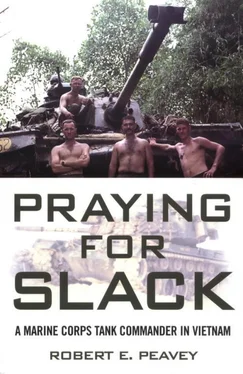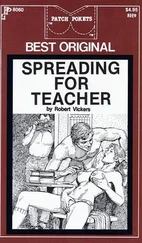Hearing that regiment number, I froze. “Which battalion of the Ninth Marines?” I asked. “It’s not One-Nine, is it? Anybody but the First!”
In northern I Corps, that was the first question any other normal man would have asked. No one in his right mind wanted to work with the 1/9. But at least the 9th Marine Regiment had three battalions—1st, 2nd, and 3rd, so the odds were two-to-one in my favor. This time, the luck of the draw was with me. “Two-Niner,” said the voice over the radio.
We left Dong Ha and drove west past Cam Lo in the direction of the Rock Pile, where we met up with 2/9 and got briefed on the sweep. It was to be a search-and-destroy mission, our main objective being the insertion of two sniper teams during our sweep northeast of the Rock Pile. I’d heard about our Marine sniper teams and their legendary accomplishments of shots farther than 1,000 meters—better than three-fifths of a mile. But until that morning, I never had the chance to meet one.
Each team was made up of two men, the spotter and the shooter. Often they sat for days to wait for a single shot on some unsuspecting North Vietnamese soldier. But sniper teams were one of our best psychological weapons during the war, second only to the B-52 Arc Lights. Imagine the mind-job a good sniper can wreak when the head on the guy next to you explodes—without you hearing a shot! The bullet, traveling faster than sound, arrives before the report from the rifle. Several seconds before the shot is even heard, the body has hit the ground. That would leave a strong impression upon anyone in the vicinity, long after they ducked for cover.
Both of the two-man teams would be riding in on the back of the tanks as we supported the grunts on their search-and-destroy mission. The sweep’s covert purpose, however, was to secretly drop—or insert—these two teams as we proceeded onward. At a time of their own choosing, the four men would slip off the back of our tanks and hide in the tall grass. We were to move on without stopping, leaving them behind.
I signaled to the four men approaching the tanks by holding up two fingers and pointing to the tank to my right, and then two fingers again waving them up on the back of Pray for Slack . As the second pair climbed on board, I couldn’t help noticing that one of them had stenciled on his helmet, in large black letters, 13 KILLERS. Not understanding, I asked him, “What’s the thirteen cents for?”
He reached inside his shirt and, from beneath his armpit, pulled out three bullets. “Each one costs Uncle Sam thirteen cents,” he said.
“You keep your ammunition under your armpits?” I asked, incredulous.
“Keeps ’em at the same temperature, no matter where you are.”
Whoa! I thought to myself. That was really splitting hairs—or did a bullet’s temperature make that big of a difference?
The second guy was still on the ground, waiting to climb up on the tank. The aluminum case he carried was five feet long and perhaps four inches thick. I knew a gun case when I saw one, but couldn’t fathom why anyone in The Nam would be toting one around. It wasn’t like these boys were going out deer hunting.
The first sniper took the case from his partner and sidestepped past the turret with it. His partner climbed up. Working his way over to my side of the turret, he asked if, after the sweep, I wouldn’t mind bringing the cases back and leaving them with the grunts.
“No problem,” I told him.
I was really surprised to see that this second guy had an M14 slung over his shoulder. He noticed my own M14 hanging from the side of the tank commander’s cupola, much like the Winchester on a cowboy’s horse, and gave me a thumbs-up to acknowledge that we both knew a good rifle when we saw one.
But I was more fascinated by what kind of surprise was in the aluminum case. “What’s in the box?” I asked our new guests.
The team leader set it up on the gypsy rack and lifted the lid proudly, like a surgeon pulling open a drawer to show you his scalpels, then tipped the box to give me a better look. Inside was a Remington Model 700 with a large Redfield telescopic sight. You know how, when a close friend shows you his racy new sports car, you don’t ask to drive it until he offers you a spin? This was one of those times. I so wanted to pick it up, but I knew the surgeon wouldn’t want his instruments contaminated.
He closed the box and flipped the latches, never offering to let me try it out. “The most cost-effective weapon in the Marine Corps,” he said. “One shot, one kill. Thirteen cents.”
The regular grunts were ready to move out, and we began the sweep, into an area I had never seen before. The trees and brush began to thin out into tall grass. I constantly scanned the area, checked on my other tanks, and made sure the grunts were well in front of us.
I was looking at the ground when I saw them—tank tracks! They were impressions made in the ground from a vehicle I didn’t recognize.
We had yet to see an enemy tank, but all tankers on the DMZ feared meeting one. Whoever shot first would likely be the winner. Reports that they were in the area were taken so seriously that our ready rack had three HEAT rounds in the first three positions, where the loader could reach them the fastest.
I caught the eye of the tank commanders on either side of me, pointed my hand down at the ground, then up to the ridgeline. I keyed my helmet microphone and used the proper code words, “Enemy tiger tracks going up the hill. Be ready, just in case.”
We began creeping up a moderately steep ridge. The heads of the grunts in front of us disappeared over the top of ridgeline. I told the loader and gunner to have a HEAT round halfway into the chamber of the main gun and instructed the driver to slow down, creep to the top of the hill, and be ready to stop on my command. I told the other tanks to stop and let me take a gander first: I wanted to scope out the area that was on the other side before driving into a possible ambush. Meanwhile, I wanted my head to be the only thing exposed above the ridgeline. Sitting atop the ridgeline would needlessly silhouette us, making us a juicy target for a would-be NVA tank.
I looked over the rise. The coast seemed clear, but there might be an enemy tiger I didn’t see, and I didn’t want any single tank of ours to be a lone target. I told the other tanks that we would all crest the ridgeline together—as fast as possible. My last instruction was, “Keep alert and watch out for a possible enemy tiger.”
It was the start of a very confusing situation.
All this time, our company CP back in Dong Ha was monitoring our radio conversation. This was standard operating procedure. But because we rarely talked with them, I never gave it much thought.
When we broached the top of the ridgeline, falling away in front of us was an awesomely lush valley. A sea of grass about three feet high was being blown by the wind as if being brushed by an invisible hand. That unbelievably beautiful sight was unlike anything I had ever seen in this miserable country. In this peaceful Eden, there was no place for an enemy tank to hide.
The two sniper teams slid off the back of the tanks, leaving their gun cases behind. We lost sight of them almost immediately, as they melted into the tall grass. I couldn’t help but admire and respect those guys. They were the true loners of the Marine Corps, and theirs was the purest form of combat: one man, one rifle, one shot.
“Good luck!” I yelled back, but the noise of the tank’s engine drowned out my words. Even if they had heard me, they wouldn’t have acknowledged it. This was the most dangerous part of their mission—separating from the main body of troops under the watchful eyes of Mr. Charles. Their life expectancy was directly proportional to the degree of stealth they maintained, and all they wanted to do was disappear.
Читать дальше












